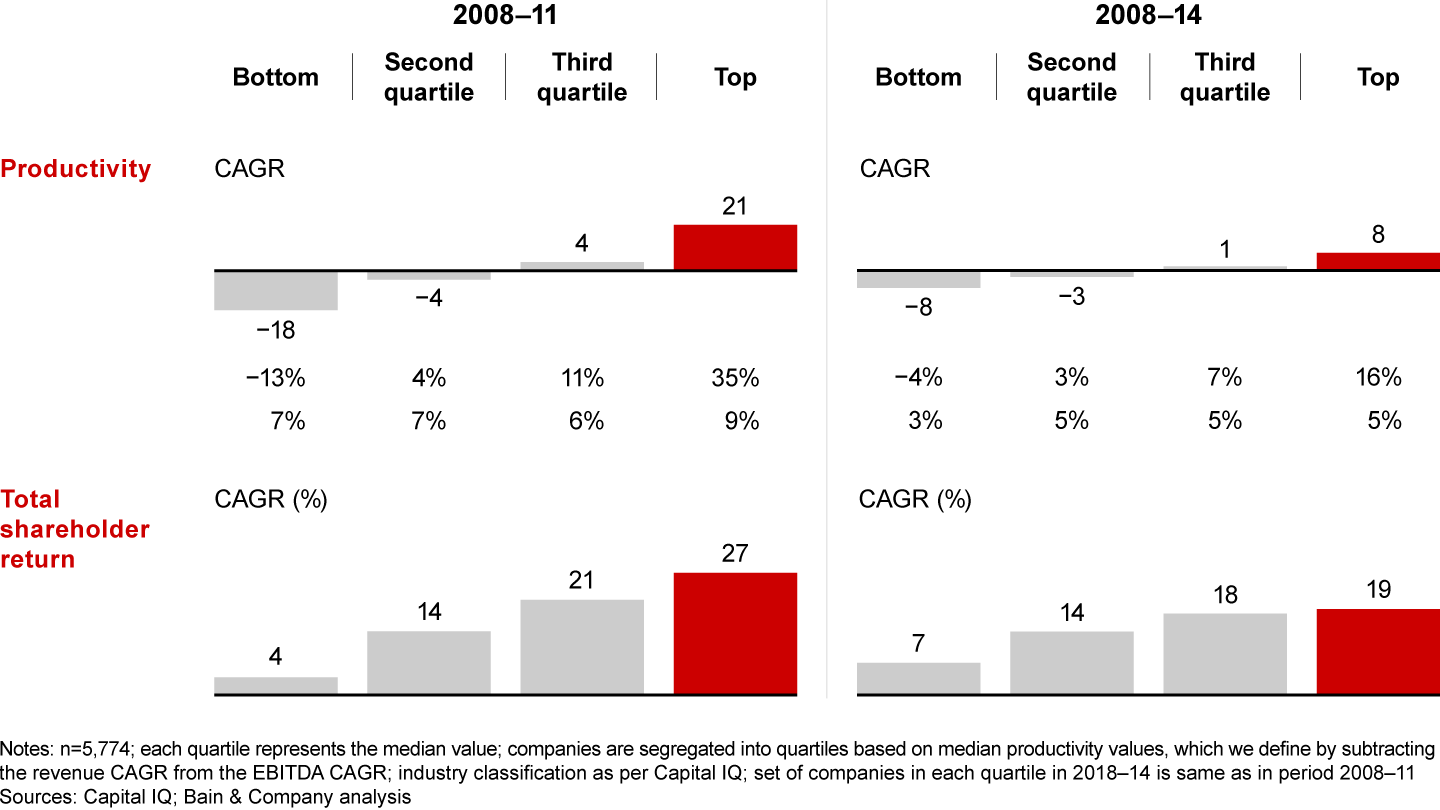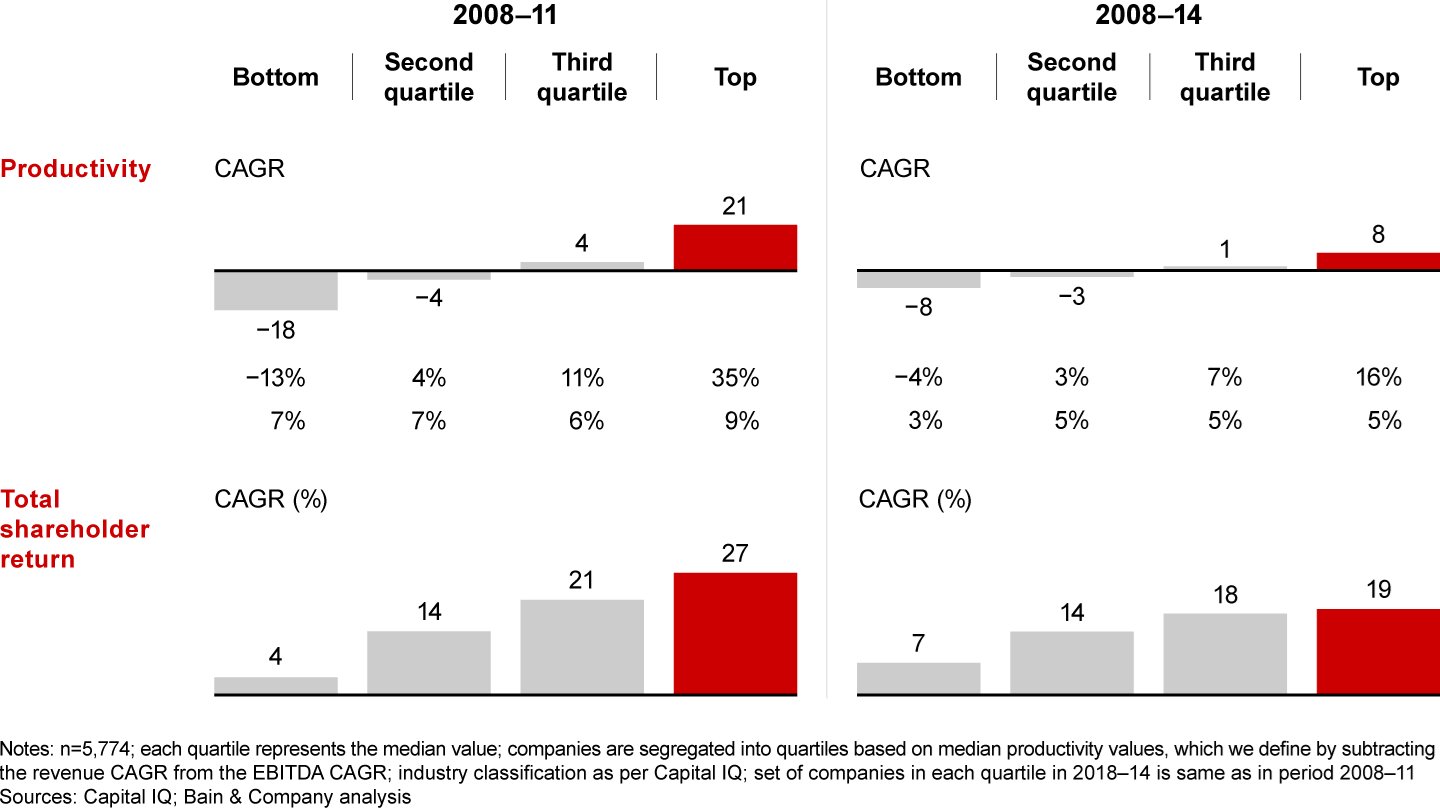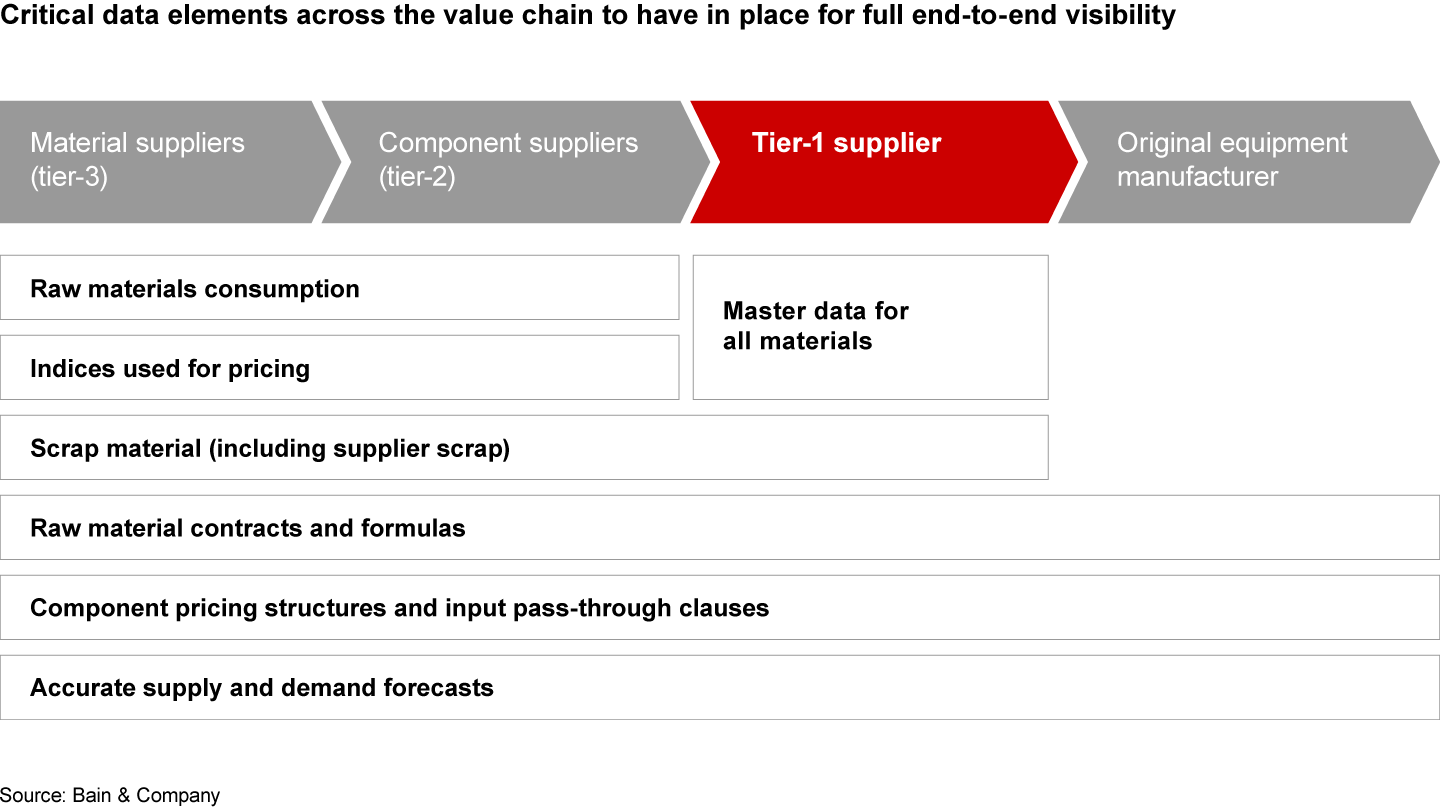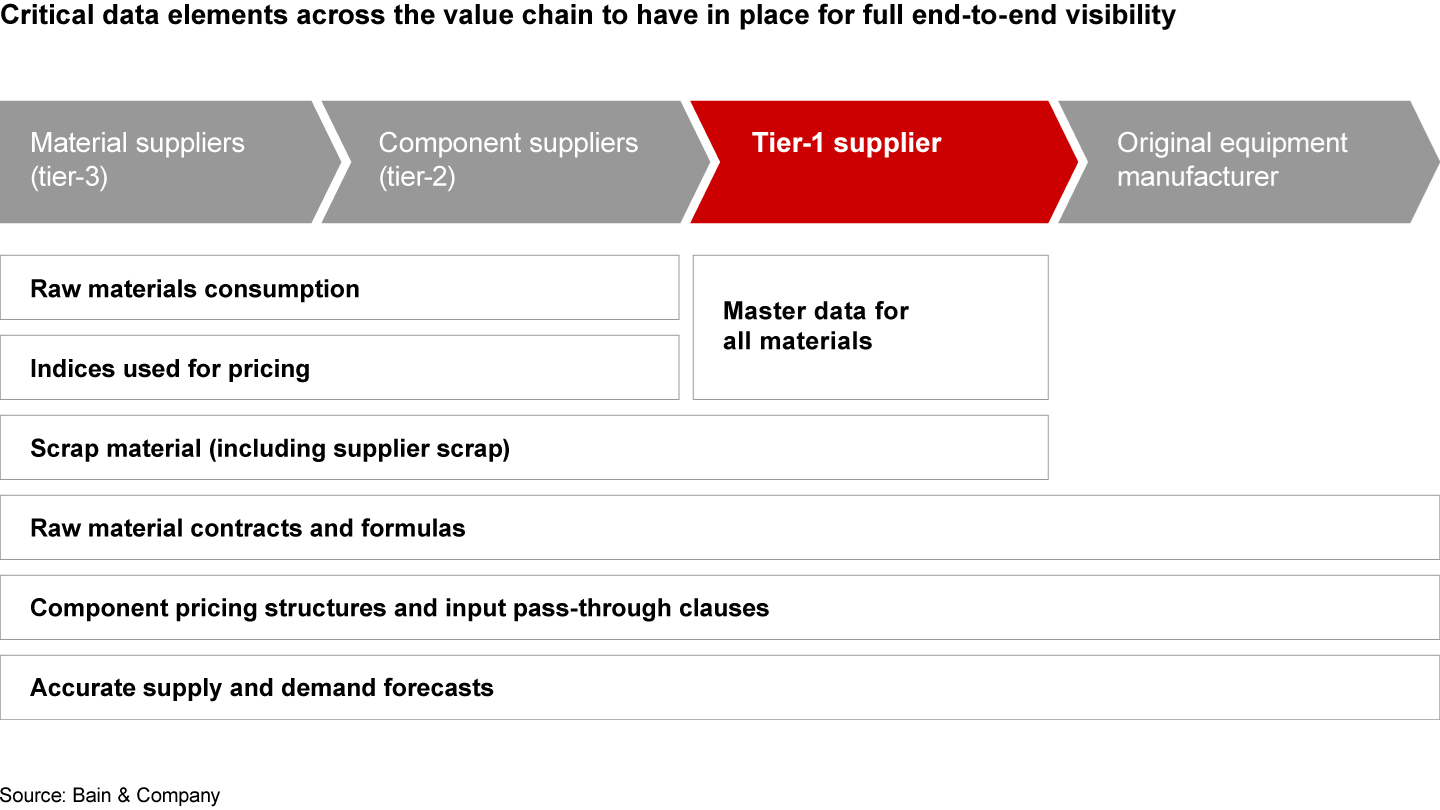Brief

Executive Summary
- Improved transparency, new sourcing strategies, and strong execution can help counter inflation and supply volatility.
- In times of inflation, top-performing companies double down on productivity gains.
- Cross-functional teams that “spend better” can pare overall cost.
Business leaders that need a reminder of the imperative for strategic procurement capabilities as they face the double punch of rapid inflation and supply shortages should consider the following recent examples:
- An agricultural raw materials converter experiencing a 275% year-over-year cost increase on its most critical ocean freight lane
- A consumer products company facing 25% cost inflation on critical packaging subcategories, threatening product margins
- A global automotive supplier dealing with a 30% increase in rubber cost resulting from rising crude oil costs, freight rates, and constrained supplies
- A global industrial equipment manufacturer experiencing severe shortages of components due to competition for underlying raw materials, as well as sharply increasing prices, especially for steel, leading to EBIT reductions
The difference between winning and losing in this environment is stark: Emerging winners are keeping costs below the inflation line, and in some areas, they are even generating P&L gains while also assuring supply security and quality. At the other end, for some companies, inflation and supply shortages are puncturing earnings.
The precedents are instructive: Top-performing companies that accelerated out of the last period of high inflation were those that made productivity improvement a top priority (see Figure 1).
Companies that doubled down on productivity in the downturn had better total shareholder return (TSR) in the short and long terms


We expect leaders to repeat this pattern as inflation ticks up again. What’s different this time is that the capabilities that enabled procurement organizations to generate year-over-year cost reductions in the past are not enough in the face of today’s turbulent conditions. While still important, “should-cost” modeling tools and competitive bidding practices are not as effective when underlying input costs are rising at double-digit rates and supply is tight. Leading companies ensure that their procurement organizations play a strategic role in bringing together internal and external stakeholders to take three essential actions: Create transparency, revamp the firm’s sourcing strategies, and execute seamlessly. Let’s take a closer look at how these actions make a difference.
Action 1: Create transparency
Procurement executives dread telling business stakeholders and CFOs about negative surprises on cost or supply availability. Yet those conversations are common due to limited upstream visibility and the lack of full traceability. Good data on third-party spending alone won’t solve the problem. Procurement functions need two additional things to mitigate the risk of nasty surprises: traceability across the entire value chain, and short- and long-term demand and supply forecasts.
Leading companies are enhancing internal spend visibility and analytics with supplier-provided reporting to improve transparency, creating a single source of truth on external outlays. Procurement teams are also partnering with the supply chain function to create end-to-end traceability within the value chain. Price and supply volatility now make it urgent to achieve full transparency on suppliers and raw materials, down to tier-3 or tier-4 suppliers (see Figure 2). This allows them to forecast properly and mitigate supply availability issues. And, of course, improved transparency supports enterprise-wide environmental, social, and governance (ESG) efforts.
Raw material visibility across the entire supply chain is critical to tier-1 supply management


Finally, leading procurement teams are bringing together a short- and long-term view of demand and supply forecasts, including constrained and unconstrained scenarios. They are integrating data into a robust category dashboard linked to internal and external inputs. Dashboards enable organizations to understand current inflation and supply-and-demand dynamics as well as to better anticipate future fluctuations.
Take the example of a tier-1 automotive supplier struggling to mitigate inflation and supply scarcity risks. The leadership team lacked full visibility into raw material pricing and sources. To address that problem, the procurement team wielded data-forecasting tools to gauge critical raw material price increases and shortages far down the value chain—and their implications on a specific customer product. The effort provided the company with powerful information for negotiations and indexing, both with suppliers and customers.
As major disruptive events become more commonplace, leading companies are making significant changes to their procurement systems, creating sustainable data visibility and embedding predictive analytical tools (see "Master Your Supplier Universe with Digital Procurement").
Many companies also struggle to align on the magnitude of the challenge before deciding how to act. A key step is establishing clear cross-functional roles and decision rights across procurement, finance, and the business’s relevant stakeholders including supply chain, commercial, engineering, and IT. Having the right forums and escalation mechanisms to mitigate inflation and supply scarcity across the entire business also support alignment.
Action 2: Revamp sourcing strategies
When the full risk exposure is transparent, procurement teams have the ability and incentive to act. Traditional price negotiation strategies are less effective in the current environment. Instead, leading procurement organizations are deploying more sophisticated sourcing techniques including parametric pricing, consortium buying, index-based pricing, and hedging strategies. These advanced techniques that focus on big-picture holistic value are essential to minimize inflation and scarcity impacts and position the business to accelerate out of turbulence.
The tier-1 auto supplier mentioned above struggled to use indices effectively in its raw material contracts. Its scattershot approach resulted in high internal complexity and failed to generate value. The solution was a customized strategy on how to use indices across different raw material segments. That approach gave commodity managers a clear understanding of when to use specific indices and how to use each index to maximize value.
The company was able to identify double-digit cost savings by tying index-based adjustments to the proper underlying material. The procurement team also helped dramatically simplify the number of indexes used. In one case, it found ways to cut the number of aluminum indexes by more than half. The firm also launched an effort to reduce its total global risk by making sure procurement and commercial teams aligned on pass-through price changes.
While advanced sourcing techniques are important, winning companies are realizing even more value by establishing cross-functional teams to “spend better” to pare overall costs. Leaders are moving beyond inflation mitigation and cost reduction in certain categories while securing supply. Some actions are simple, such as using policy and internal controls to curtail usage of certain items. Others are more complex, such as applying value engineering to lower the cost of complex machined parts. What matters is taking an unconstrained approach to reducing the total cost of ownership.
In fact, it’s an opportune moment to tackle more fundamental change since supply shortages and price increases provide an incentive for engineering and other stakeholders to collaborate on sourcing. The procurement team at one mining company, for example, was faced with a 170% increase in transport costs for internal material movements. And the presence of much larger mining companies nearby reduced the company’s leverage and ability to secure supply. Faced with these headwinds, the procurement team spearheaded a joint initiative with the operations team to develop an updated production forecast model. That helped them identify a demand-smoothing opportunity, deferring trips to enable backhauls and reducing annual costs by nearly 25%.
Beyond category management tactics, procurement teams at leading companies also play a role in supporting topline growth. While there are natural limits to procurement’s influence on a company’s pricing actions, savvy teams play a key role in ensuring alignment across all relevant functions, including supply chain, finance, and commercial operations. This ensures that inflation and indirect supply assurance costs are accurately forecast, tracked, reported, and reflected in pricing.
Upstream, transparency is vital to commercial teams in difficult customer conversations. Just as procurement professionals expect suppliers to provide details of cost increases, they should also be arming their commercial teams with the right data to adjust pricing when needed to protect the bottom line from inflation (see "How B2B Firms Can Price with Confidence as Inflation Rises").
Action 3: Execute seamlessly
Strategic procurement in an inflationary environment requires strong execution. The first step is to communicate clearly with all key stakeholders about implementing the procurement strategy and the expected outcomes. When the team initiates engineering redesigns or approves new suppliers to address scarcity concerns, for instance, leading organizations ensure that everyone involved is clear on the outcomes and is collaborating on critical issues.
Improving data visibility with the finance and commercial teams often surfaces opportunities to adjust budgets with improved forecasting and reporting accuracy, and to flow through price adjustments to customers, where contracts allow. Similarly, updating supply scarcity concerns and mitigation action plans with supply chain teams and other relevant business units helps to limit the risks associated with fulfilling customer contracts.
Leading companies also adjust supplier pricing downward when inflation eases. A clear and simple guideline helps to set the agenda at top procurement organizations: Follow the same assessment and alignment process for upward and downward inflationary periods to identify easing and the opportunity to adjust pricing down.
Getting started
The dual challenge of inflation and supply insecurity presents a major opportunity for procurement organizations. CPOs, CFOs, and business leaders can help position the business to accelerate out of turbulence by asking a few questions:
- Do we have robust traceability and is it integrated with supply-and-demand forecasts to highlight risks and exposures across the value chain?
- Can we rapidly notify our cross-functional stakeholders when we see shocks coming to align on the magnitude of the challenge?
- Do our category strategies include advanced sourcing techniques and playbooks to execute more complex, cross-functional “spend better” opportunities?
- Does our closed-loop system encourage accountability for actions and clarity on outcomes?
The answers to these questions will vary from company to company. But posing the questions is an important catalyst. It requires the procurement team to push for increased transparency across the entire supply chain and orchestrate an enterprise-wide strategy that can transform performance in an increasingly difficult business environment.